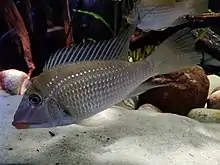| Satanoperca jurupari | |
|---|---|
 | |
| Satanoperca jurupari, London Zoo. | |
| Scientific classification | |
| Domain: | Eukaryota |
| Kingdom: | Animalia |
| Phylum: | Chordata |
| Class: | Actinopterygii |
| Order: | Cichliformes |
| Family: | Cichlidae |
| Genus: | Satanoperca |
| Species: | S. jurupari |
| Binomial name | |
| Satanoperca jurupari (Heckel, 1840) | |
| Synonyms | |
| |
Satanoperca jurupari, the demon eartheater, is a species of cichlid endemic to the Amazon basin in South America. It can reach a length of 18.5 centimetres (7.3 in) SL.
Feeding behavior and diet
Like some other Geophagini cichlids, the common name 'eartheater' is attributed to their common feeding strategy of sifting through substrate (e.g., sand, small rock, silt) for food, where mouthfuls of substrate are taken up and sorted in the buccal cavity for food items. With the help of gill rakers, food is sorted and substrate is either spat out or sifted out from the operculum. While generally considered to be an invertivore, it has been documented as an omnivore in systems that have been disturbed by human activity.[1]
Commercial importance
This species is of little importance to local commercial fisheries but has grown in popularity among the aquarium trade over the past several years.[2]
Breeding and reproduction
As with most cichlids, this species does exhibit parental care. Parents will typically spawn in selected substrate and, after 24 hours, incubate eggs in the buccal cavity where young will seek refuge during the larval stage.[3]
Behavior
This fish is usually peaceful, until the mating season, when it becomes very aggressive.
References
- ↑ B. de Mérona; M. dos Santos; R. G. De Almeida (2001). "Short term effects of Tucuruí Dam (Amazonia, Brazil) on the trophic organization of fish communities". Environmental Biology of Fishes. 60 (1): 375–392. doi:10.1023/A:1011033025706.
- ↑ Froese, Rainer; Pauly, Daniel (eds.) (2013). "Satanoperca jurupari" in FishBase. April 2013 version.
- ↑ M. Reid; J. Atz (1958). "Oral incubation in the cichlid fish Geophagus jurupari". Zoologica. 43 (1): 77–88.